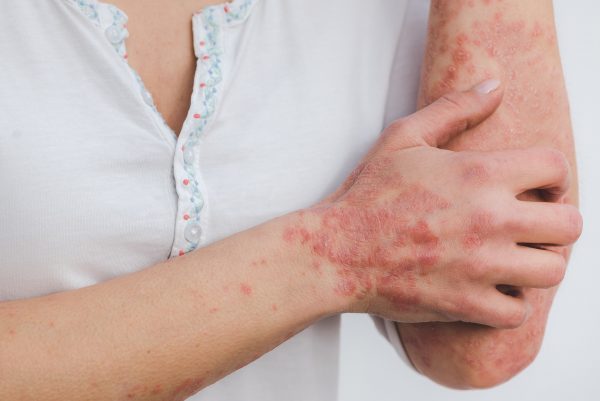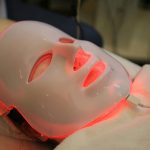Have you ever noticed that certain skin problems run in some families? Mom, Dad and the kids all seem to have the same sort of problems. Perhaps it’s life-long issues with psoriasis. Or maybe it’s eczema. There is a reason for this.
In particular, family members who grow up in the same household often follow the same eating habits.
Let’s say Mom and Dad grew up eating meat, dairy, white bread and sugary desserts at most of their meals. They end up feeding the same foods to their kids, and the kids pass the legacy on to the grandkids.
Well, the thing with meat and dairy is that they break down into leucine, which can produce something called insulin-like growth factor-1 (IGF-1) in the human body. Combined with the breakdown of processed carbohydrates, this can increase IGF-1 even further.
The problem here is that excess IGF-1 promotes inflammation; and inflammation triggers skin issues such as acne, eczema and psoriasis.
Not only that, but IGF-1 plays a role in the production of sebum – the oily substance that coats your skin – and causes the outer layer of skin cells to harden and dry. This leads to acne, blackheads and even skin tags.
So when it comes to skin conditions, maybe we should focus more on what we are putting into our bodies instead of concentrating on soaps, creams, lotions and other moisturizers to try and help resolve our skin issues.
Healthy Skin Starts in the Gut
What you feed your body is eventually going to show up on your skin. It all has to do with how the foods you eat affect your gut microbiome.
Some foods help friendly, anti-inflammatory gut microbes to thrive. Other foods increase levels of the unhealthy microbes that cause low-grade inflammation in most body systems. This includes functions of the skin, which is the largest organ of the body.
We call this the gut-skin axis. It’s basically a bidirectional relationship between the gut microbiome and skin health. A disproportionate amount of bad vs. good gut organisms is often seen in inflammatory skin conditions like psoriasis, eczema and rosacea.
The gut also influences how the immune system functions. This is what we often see in psoriasis patients who develop raised, scaly skin plaques on the elbows, knees and scalp. In a nutshell, the plaques are a result of an overactive immune response that stimulate excessive skin growth.
However, studies have shown that the use of probiotics and prebiotics, which promote healthy gut bacteria and improve immune function, can effectively help treat, manage and improve psoriasis symptoms.
And then there is atopic dermatitis, including eczema. It generally appears as a red rash and dry skin, although dry, cracked scaly patches are often seen.
Again, research suggests that it all begins in the gut microbiome…. and supports supplementation with probiotics and prebiotics to improve symptoms.
This just goes to show you how a small alteration in your gut health can encourage healthy skin.
Image how much more improvement you could achieve if you switched to a gut healthy diet!
What to Eat for a Healthy Gut and Skin
While I’ve touched on only a few skin conditions today, an imbalanced gut microbiome that produces inflammation and disturbs the immune response plays a role in so many others. So if you want healthy skin, it makes good sense to feed your gut the food it deserves.
Higher quantities of meat, dairy, fast foods and refined carbs are going to reduce levels of good gut microbes, alter immune function and increase inflammation. And it’s not just your skin that experiences these negative effects. It is every organ and system within your body.
That being said, I say we get rid of those foods and switch things up a bit!
Choose to eat vegetables in all colors of the rainbow. Organic greens, tomatoes, rutabagas, broccoli, squash, cauliflower, carrots, avocadoes, sweet potatoes and other colored veggies all have a place at your dinner table.
Vary your fruit choices. Apples, bananas and oranges are very common fruit choices. But they don’t even scratch the surface. In addition to these common choices, try adding berries, melons, kiwi, pineapple, apricots and other fresh, delicious fruits.
Add tree nuts to your snacks and meals. Give up on peanuts. They aren’t even “real” nuts. They fall into the legume category… they are one of today’s top allergens… and they contain aflatoxin. This is a natural toxin that’s been shown to cause cancer in rats.
Your better choice is to choose a nice variety of Brazil nuts, walnuts, pecans, pistachios and other tree nuts. Buy organic, unsalted brands. Most all of them can increase the abundance of gut bacteria that have anti-inflammatory and probiotic activities.
Enjoy more fermented foods. They’re a great source of natural probiotics that feed your gut. Kombucha, kimchi, miso, natto, kefir, tempeh and sauerkraut are all fermented foods.
Eat less animal protein and more plant protein. Most folks tend to get most of their protein from animal sources rather than plant sources. However, these two different sources have exactly opposite effects on your gut microbiota. Limit animal proteins to 15% or less of your diet.
Take a probiotic daily with your largest meal of the day. Look for one that contains multiple strains of lactobacillus and bifidobacterium. The more strains and the higher the colony count, the better off you will be. It should also include a “prebiotic” to help the good bacteria thrive in your gut.
It is also a good idea to get your levels of vitamin D tested. Insufficient levels of this nutrient are linked to numerous skin conditions, including psoriasis, eczema and acne. The test is easy, insurance typically pays for it and, if you’re insufficient, vitamin D supplements themselves are very inexpensive.
SOURCES:
Okoro OE, Camera E, Flori E, Ottaviani M. Insulin and the sebaceous gland function. Front Physiol. 2023 Sep 1;14:1252972.
Farag AGA, Abdu Allah AMK, El-Rebey HS, Mohamed Ibraheem KI, Mohamed ASED, Labeeb AZ, Elgazzar AE, Haggag MM. Role of insulin-like growth factor-1 in skin tags: a clinical, genetic and immunohistochemical study in a sample of Egyptian patients. Clin Cosmet Investig Dermatol. 2019 Apr 26;12:255-266.
Melnik B. Dietary intervention in acne: Attenuation of increased mTORC1 signaling promoted by Western diet. Dermatoendocrinol. 2012 Jan 1;4(1):20-32.
Thye AY, Bah YR, Law JW, Tan LT, He YW, Wong SH, Thurairajasingam S, Chan KG, Lee LH, Letchumanan V. Gut-Skin Axis: Unravelling the Connection between the Gut Microbiome and Psoriasis. Biomedicines. 2022 Apr 30;10(5):1037.
Notay M, Foolad N, Vaughn AR, Sivamani RK. Probiotics, Prebiotics, and Synbiotics for the Treatment and Prevention of Adult Dermatological Diseases. Am J Clin Dermatol. 2017 Dec;18(6):721-732.



